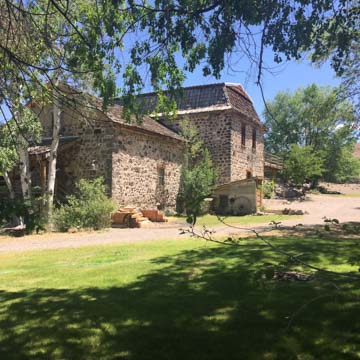You are here
Glenwood Grist Mill
The Glenwood Gristmill, also known as the Wall Mill, was one of the first grist mills in Sevier County and one of the only remaining pioneer mills in Utah. It was commissioned by the Church of Jesus Christ of Latter-day Saints (LDS Church) as a building block of its territorial expansion into Native American lands. Yet it became part of the history of disagreements between LDS Church leaders and their Mormon followers.
The town of Glenwood was established in 1863. The mill was built in 1874, three years after hostilities with Fremont tribes were resolved through trade treaties. LDS Church members had first been sent to take control of the fresh water springs, an essential resource of the native communities, and to create a Mormon agrarian settlement in the area. Joseph Laban Wall, an English convert to the faith, built the mill with the help of his brother, Francis George Wall. Joseph was deeply religious, and together with his sister had immigrated to Salt Lake City in 1856. In 1866, the LDS Church sent Wall with several other families to settle Glenwood. With peace secured, the church leaders ordered Wall to invest in a flour mill, which was necessary for the town to survive. The closest mill in Manti was a sixty-mile round trip. The project was financed as a private enterprise by Mr. Atwood, who had come to Utah in the same handcart company with the Walls.
Wall carved out a 14.32-acre parcel at the bottom of Mill Canyon, where the hilly terrain levels to a flat plane. Using fieldstone and mortar, he built a one-and-a-half-story rectangular building with a gabled roof. The attic walls on the shorter ends of the building were filled in with brick. Small windows lined the longer sides of the building and the front door and attic window were centered on the facade.
Water from Glenwood Springs, about a mile east of the mill, traveled via a feeder canal to a hilltop pond and down a wooden headrace to an overshot wheel. An adjustable sluice gate controlled the flow into the wheel buckets, which allowed the weight of the water to turn the wheel rather than the water pressure. This exterior wheel was connected by an axle to an interior wheel. The grain was crushed by rotating cams that dropped stampers onto the grain and then it was ground between a fixed and a rotating millstone with grooves. The attic was equipped with a hopper and a chute to deliver the grain to grindstones. The grindstones dropped the grain into a chute, where it poured into bags. Another chute slid the bags outside directly onto horse carts that transported them to the town; the carts returned with raw grain from granaries.
After the Panic of 1873, the LDS Church established a communal grist mill under the Glenwood United Order, which ultimately disbanded in 1881. Wall refused to operate as part of the communal system, and maintained his mill as a private enterprise during that time. He eventually sold it in 1897, a year before his death. Around the turn of the twentieth century, the new owners built a large, two-story addition with a mansard roof to the mill’s east end, forming a T-shaped plan. The expansion included the latest technology in mill design: turbine power and roller mills. The improved mill produced finer, less acidic flour that could be stored for longer periods. These advances enabled the mill to compete with cheaper flours introduced to the local market by the Rio Grande Railroad.
The mill reached its highest productivity in 1915 but it continued to operate well into the 1940s. It ultimately closed after World War II. In 1957, the building was repurposed to house game birds. In 1971, it was remodeled and converted into a private residence, which it remains today. Though the interior has been much altered, the exterior maintains its historic integrity.
References
Writing Credits
If SAH Archipedia has been useful to you, please consider supporting it.
SAH Archipedia tells the story of the United States through its buildings, landscapes, and cities. This freely available resource empowers the public with authoritative knowledge that deepens their understanding and appreciation of the built environment. But the Society of Architectural Historians, which created SAH Archipedia with University of Virginia Press, needs your support to maintain the high-caliber research, writing, photography, cartography, editing, design, and programming that make SAH Archipedia a trusted online resource available to all who value the history of place, heritage tourism, and learning.














